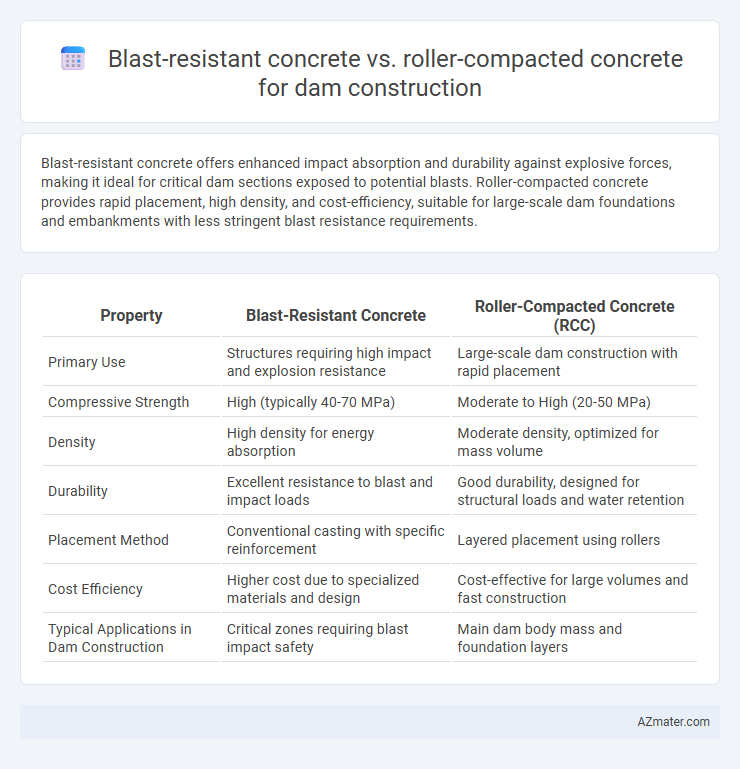Blast-resistant concrete offers enhanced impact absorption and durability against explosive forces, making it ideal for critical dam sections exposed to potential blasts. Roller-compacted concrete provides rapid placement, high density, and cost-efficiency, suitable for large-scale dam foundations and embankments with less stringent blast resistance requirements.
Table of Comparison
| Property | Blast-Resistant Concrete | Roller-Compacted Concrete (RCC) |
|---|---|---|
| Primary Use | Structures requiring high impact and explosion resistance | Large-scale dam construction with rapid placement |
| Compressive Strength | High (typically 40-70 MPa) | Moderate to High (20-50 MPa) |
| Density | High density for energy absorption | Moderate density, optimized for mass volume |
| Durability | Excellent resistance to blast and impact loads | Good durability, designed for structural loads and water retention |
| Placement Method | Conventional casting with specific reinforcement | Layered placement using rollers |
| Cost Efficiency | Higher cost due to specialized materials and design | Cost-effective for large volumes and fast construction |
| Typical Applications in Dam Construction | Critical zones requiring blast impact safety | Main dam body mass and foundation layers |
Introduction to Dam Construction Materials
Blast-resistant concrete for dam construction offers enhanced durability and resilience against explosive forces, making it ideal for high-risk environments prone to seismic or man-made blasts. Roller-compacted concrete (RCC) is widely used in dam construction due to its rapid placement, cost-effectiveness, and strong compressive strength, facilitating large-scale projects with reduced construction time. Both materials contribute to structural stability, but selection depends on specific project requirements like load resistance and environmental conditions.
Overview of Blast-Resistant Concrete
Blast-resistant concrete is engineered to withstand high-pressure shock waves and explosive impacts, making it ideal for critical infrastructure like dams in seismic or conflict-prone zones. Its composition typically includes fiber reinforcement, high-strength aggregates, and increased density to absorb and dissipate blast energy efficiently. Compared to roller-compacted concrete, which emphasizes rapid construction and cost-effectiveness, blast-resistant concrete prioritizes enhanced durability and structural integrity under extreme impact conditions.
Basics of Roller-Compacted Concrete (RCC)
Roller-compacted concrete (RCC) for dam construction is a dense, no-slump concrete mix placed with heavy rollers, providing rapid construction and high durability. RCC offers excellent compressive strength and reduced cement content compared to blast-resistant concrete, enhancing cost-effectiveness and ease of placement. Its low permeability and robust interlocking particle structure make RCC ideal for large-scale dam projects requiring structural stability and resistance to environmental stresses.
Material Composition and Structural Properties
Blast-resistant concrete for dam construction incorporates high-strength aggregates, fiber reinforcements, and air-entraining agents to enhance impact resistance and energy absorption, providing superior durability against explosive forces. Roller-compacted concrete (RCC) uses a drier mix with lower water content, incorporating coarse aggregates and minimal cement paste, allowing for rapid placement and compaction while maintaining dense structural integrity. The structural properties of blast-resistant concrete emphasize toughness and crack resistance under dynamic loads, whereas RCC prioritizes high compressive strength and stability through layered compaction, optimizing dam construction efficiency.
Performance Under Extreme Loads
Blast-resistant concrete for dam construction offers superior energy absorption and fracture resistance under high-pressure explosive loads, minimizing structural damage. Roller-compacted concrete (RCC) provides excellent compressive strength and rapid placement but may require modifications to enhance toughness for blast resilience. The choice between these concretes hinges on balancing blast load resistance with construction speed and durability requirements specific to dam safety.
Durability and Longevity Comparison
Blast-resistant concrete offers superior durability in dam construction due to its enhanced resistance to explosive forces and impact damage, significantly reducing micro-cracking and structural degradation over time. Roller-compacted concrete (RCC) provides excellent longevity through its high density and low permeability, which minimizes water infiltration and erosion, critical factors in dam integrity. Both materials ensure extended service life, but blast-resistant concrete specifically enhances resilience against dynamic loads, while RCC excels in long-term durability under static hydrostatic pressures.
Construction Techniques and Project Timelines
Blast-resistant concrete for dam construction involves specialized mix designs and placement techniques to enhance impact resistance, requiring longer curing times and meticulous quality control, which can extend project timelines. Roller-compacted concrete (RCC) uses a dry mix placed with heavy rollers, enabling faster layering and compaction, significantly reducing construction time and allowing for rapid dam completion. The choice between these concretes affects construction scheduling, with RCC favoring accelerated timelines and blast-resistant concrete prioritizing enhanced durability under explosive stresses.
Cost Analysis and Economic Feasibility
Blast-resistant concrete offers enhanced durability and safety against explosive forces but comes at a higher initial cost due to specialized materials and mixing processes. Roller-compacted concrete (RCC) is more economical for large-scale dam construction, providing faster placement and reduced labor costs without compromising structural integrity. Economic feasibility favors RCC for most projects, though blast-resistant concrete is justified in high-risk areas where safety outweighs cost concerns.
Environmental and Sustainability Considerations
Blast-resistant concrete incorporates specialized aggregates and admixtures that enhance durability and reduce repair frequency, thereby minimizing resource consumption and environmental disturbance during dam construction. Roller-compacted concrete (RCC) offers rapid placement with lower cement content and reduced water usage, contributing to decreased carbon emissions and efficient material use, which supports sustainable construction practices. Both materials improve structural resilience while addressing environmental impact, with RCC generally providing a more energy-efficient and eco-friendly option for large-scale dam projects.
Choosing the Right Concrete for Dam Safety
Blast-resistant concrete offers superior durability and energy absorption, making it ideal for dams exposed to explosive forces or seismic activity, while roller-compacted concrete (RCC) excels in rapid placement and cost efficiency for large-scale dam construction. Selecting the right material involves evaluating site-specific risks, structural demands, and budget constraints to ensure long-term dam safety and stability. Advanced mix designs and reinforcement strategies further enhance performance, balancing strength with resilience against dynamic loads.

Infographic: Blast-resistant concrete vs Roller-compacted concrete for Dam construction
 azmater.com
azmater.com